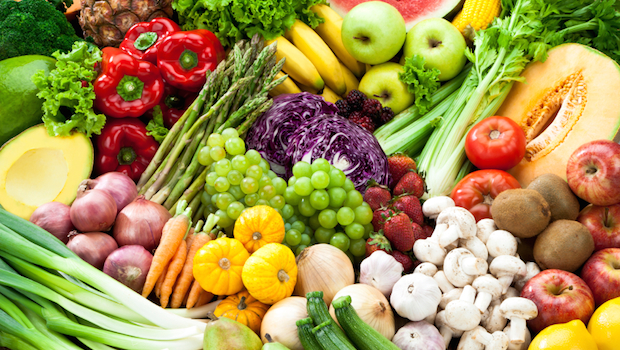If you have attended Dr. Kellie’s Stress Class you know that we encounter stressors on a daily basis. The food we eat is one of those daily stressors. We have all heard that eating organic is better for you but does it really matter in the long run?

Organic foods seem to carry a hefty price tag but the reason for that is producing organic food is costlier in every aspect of the process-including farming practices that require greater labor inputs and segregating organic ingredients from conventional ones. This makes total sense but it may make it difficult for families to work organic foods into their grocery budgets.
According to the Environmental Working Group, nearly three-quarters of 7,000 produce samples tested by the USDA in 2014 contained pesticide residues. In some cases, these pesticides persisted on fruits and vegetables even when they were washed or peeled.
Pesticide exposure has been linked to all sorts of health conditions, such as:
- Increased Risk of Cancer
- Developmental Delays in Infants and Children
- Delayed Effects of the Nervous System
- Early Commencement of Menses in Young Women (associated with growth hormones given to cows to produce more milk)
- Build-up of Toxins in the Body
Organic food not only benefits our health but it can benefit our environment. According to the Food and Agriculture Organization of the United Nations, an agency dedicated to addressing world hunger, there are many environmental benefits of organic agriculture, including long-term sustainability, greater biodiversity and better soil health.
So we can clearly see the benefits of eating organic but how can we do it if we are on a budget? Below are some great tips from The Huffington Post.
1. Prioritize your purchases.
“It is most important for young children, pregnant women, and those with weakened immune systems to eat organic food,” advised Deborah Gerszberg, a nutritionist at Columbia University’s Pancreas Center, in a blog post.
She also recommends buying organic animal products, including eggs and milk, as often as possible.
“Some companies aren’t certified organic, but still pledge not to use hormones or unnecessary antibiotics. This would be a good second choice,” she said.
Choosing organic options for things that you or your household eat in large quantities is also a recommended practice. “The repetitive intakes of pesticides from foods could cause more harm to your health than sporadic exposure,” said Lu.
For produce, buy organic if you’re planning to eat the skin of the fruit or vegetable.
“Choose organic for the foods containing the highest amount of chemical residue, and choose conventional foods for foods with the least residue,” said Gerszberg.
The Environmental Working Group’s “Dirty Dozen” and “Clean Fifteen” lists are helpful resources on this front. The first highlights conventional produce with the highest pesticide loads (such as strawberries, apples, nectarines, grapes and spinach). The “clean” list, on the other hand, catalogs produce least likely to hold pesticide residues. These include avocados, sweet corn, pineapples, cabbage and cauliflower.
2. Buy in season (and local, if possible). Buying organic produce in season tends to be much kinder on the wallet. In addition visiting a farmers market, you could try purchasing a crop share or CSA (Community Supported Agriculture) to get local, in-season produce.
Locally grown food is often fresher and tastier than the alternative.
“The crops are picked at their peak, and farmstead products like cheeses and are hand-crafted for best flavor,” writes Vern Grubinger, a vegetable and berry specialist at the University of Vermont. “Livestock products are processed in nearby facilities, and typically the farmer has direct relationship with processors, overseeing quality — unlike animals processed in large industrial facilities.”
Buying local food is a community investment, Grubinger adds — a way to not just support local businesses, but also to protect local ecosystems and help communities become more self-sufficient. It also supports a more sustainable food system by significantly minimizing the use of fossil fuel-based transportation.
It’s estimated that the average American meal travels about 1,500 miles to get from farm to plate, according to the Center for Urban Education about Sustainable Agriculture. In contrast, locally sourced food can travel 200 miles or less.
3. Buying generic and in bulk are money-savers too.
Many mainstream supermarkets, including Safeway, Target, Wal-Mart and H-E-B, carry organic store-brand options, while Costco, Sam’s Club and BJ’s sell organic foodstuffs in bulk. Some supermarkets, like Whole Foods, also have bulk bins stocked with organic grains, dried fruit, coffee and other products.
4. Keep an eye out for sales and coupons. Sites like All Natural Savings and Organic Deals can help customers surface organic food deals.
5. Grow your own food. It might sound daunting, but growing your own produce isn’t as difficult as it sounds. It just requires a bit of effort and patience. Good Housekeeping has some tips on how to start your own organic garden. Live in a small apartment? The Urban Organic Gardener website’s got you covered.
Hopefully this post has provided you with the information you need to make the right choices for you and your family. If you have time I also recommend you watch this short video.


